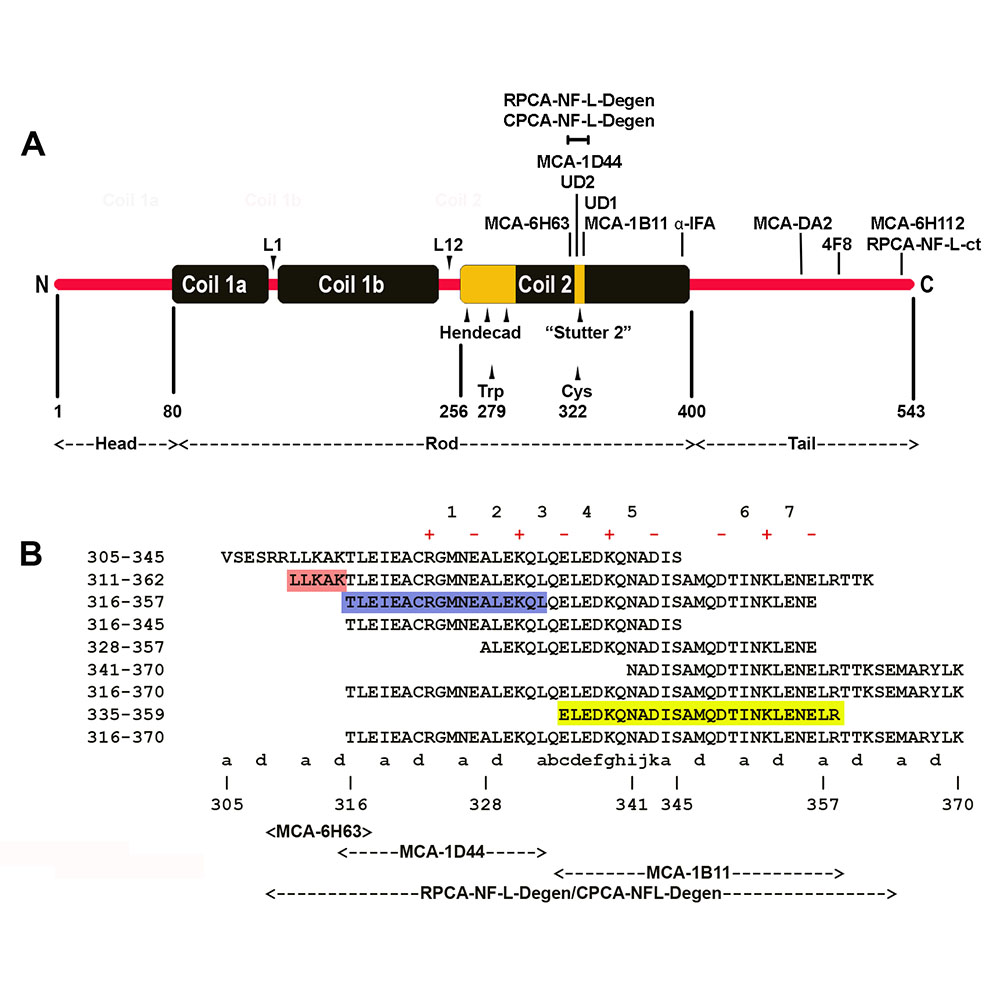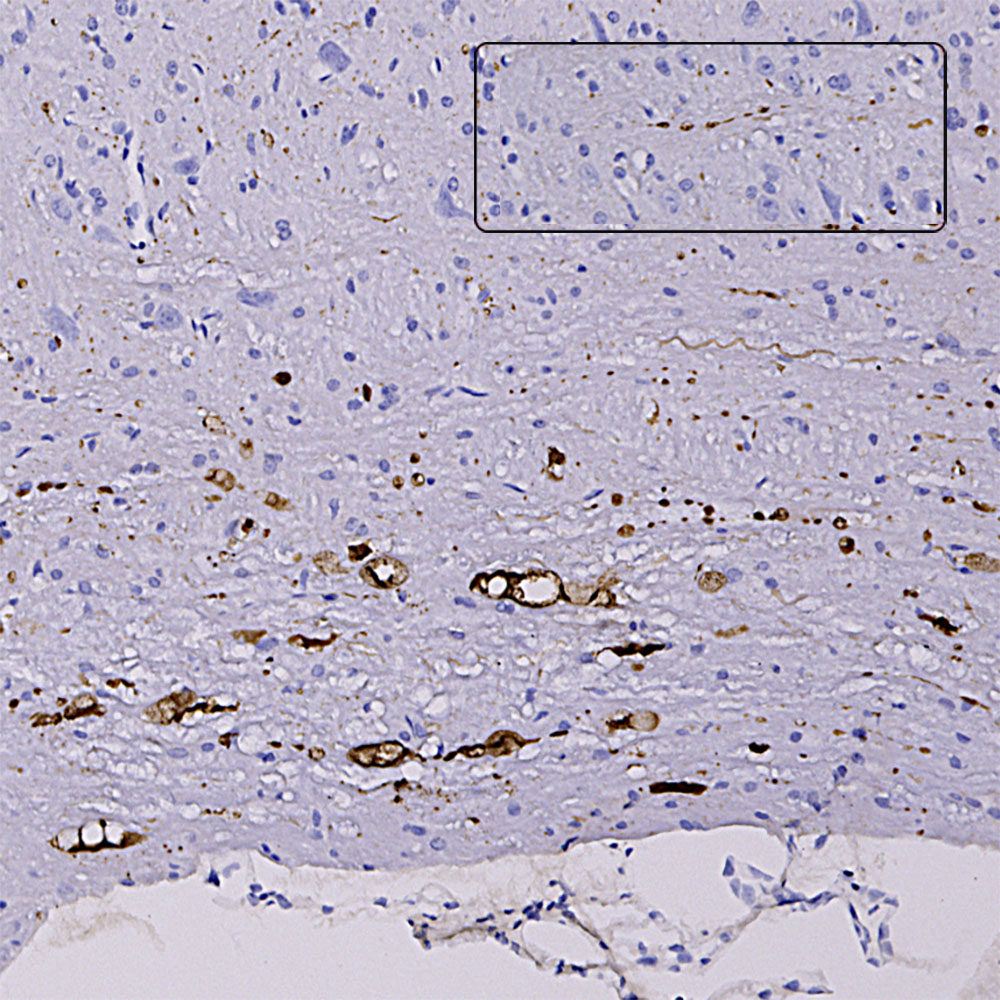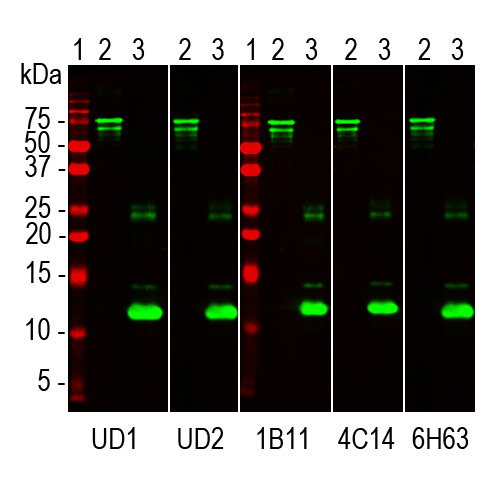| Name: | Mouse monoclonal antibody to degraded neurofilament NF-L |
| Immunogen: | Proprietary recombinant construct containing amino acids of human NF-L expressed in and purified from E. coli. |
| HGNC Name: | NEFL |
| UniProt: | P07196 |
| Molecular Weight: | 68-70kDa by SDS-PAGE |
| Host: | Mouse |
| Isotype: | IgG1 heavy, κ light |
| Species Cross-Reactivity: | Human, rat, mouse, cow, pig |
| RRID: | AB_2923484 |
| Format: | Purified antibody at 1mg/mL in 50% PBS, 50% glycerol plus 5mM NaN3 |
| Applications: | WB, ICC/IF, ELISA |
| Recommended Dilutions: | WB: 1:5,000. ICC/IF: 1:10,000 |
| Storage: | Shipped on ice. Store at 4°C for short term, for longer term at -20°C. Avoid freeze / thaw cycles. |

Immunostaining of a coronal section of the spinal cord of a rat given a midline C4 contusion injury three days previously. Sections were stained with RPCA-NF-L-ct (red) and MCA-6H63 in green. MCA-6H63 stains prominent aggregates of material concentrated in the lateral funiculi and the dorsal columns but seen in lesser amounts throughout the section. These are degenerating and degenerated axons damaged by the C4 lesion. The RPCA-NF-L-ct antibody binds the C-terminal “tail” region of NF-L which is absent or destroyed during degeneration, so the MCA-6H63 positive profiles are largely negative for RPCA-NF-L-ct.
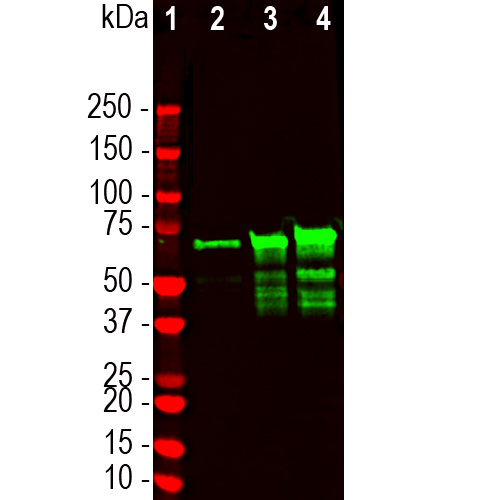
Western blotting of MCA-6H63 on crude CNS homogenates. Lane 1 shows molecular weight standards of indicated size. Lane 2 shows western blot of homogenate of E20 rat spinal cord, lane 3 homogenate of adult rat spinal cord and lane 4 shows homogenate of cow spinal cord extract. The MCA-6H63 antibody binds the denatured forms of NF-L with apparent molecular weight 68-70kDa as immobilized on western blotting membranes. Lower molecular weight bands under the major band are proteolytic fragments of NF-L.
Mouse Monoclonal Antibody to NF-L DegenoTag™ Peptide
Cat# MCA-6H63
$120.00 – $800.00
We have recently developed a series of novel antibody reagents which we call DegenoTag™ products. These are antibodies which recognize epitopes in a small segment of the neurofilament NF-L subunit which are normally not accessible to antibodies but which became available on degeneration. We have evidence that these epitopes are made accessible as a result of degeneration induced proteolysis, and in agreement with this hypothesis we could make previously negative control tissues become strongly DegenoTag™ antibody positive by treatment with proteases. In addition healthy CNS tissues do not stain with DegenoTag™ reagents except for a tiny minority of apparently spontaneously degenerating neuronal cells and processes. In stark contrast DegenoTag™ reagents strongly bind numerous profiles in tissues from animals given experimental spinal cord injuries. We also discovered that our antibodies to the C-terminal of NF-L, such as our rabbit polyclonal RPCA-NF-L-ct and mouse monoclonal MCA-DA2 fail to stain these degenerated profiles. Our reagents can therefore be used to positively identify both healthy and degenerated processes. Process and cells undergoing degeneration show both types of Degenotag™ reagent.
MCA-6H63 was raised against a proprietary recombinant immunogen based on the Coil 2 region of human NF-L. Further studies showed that the MCA-6H63 epitope is dependent on amino acids 305-316. The antibody works well on western blots of a variety of species but binds only degenerating or degenerated processes in sectioned material (7, 8). Other Uman type antibodies we market are MCA-1D44 and MCA-1B11. Full details of these findings are described in our a BioRχiv and in greater detail in a peer-reviewed publication in Brain Communications. It also works well on paraffin embedded histological sections of rodent CNS tissues, including transgenic mouse models. It is also an excellent capture reagent in ELISA. EnCor also markets other Degenotag™ reagents such chicken and rabbit polyclonals to the same NF-L region CPCA-NF-L-Degen and RPCA-NF-L-Degen which share this interesting degeneration specific staining pattern. Mouse select image above left for larger view.
Above: Epitope map of novel DegenoTag™antibodies on human NF-L including MCA-6H63. We mapped the epitopes for the two mouse monoclonal antibodies to NF-L used in the Uman Diagnostics NF-LIGHT™ assay. In the diagram these are indicated as “UD1” and UD2”. UD1 is also known as 2.1 and serves as the NF-L detection reagent while UD2 is also known as 47.3 and is the capture reagent. The same pair of antibodies are used in the Simoa™ NF-L assay of Quanterix. These are both located in a short peptide flanking the “stutter 2” region of the α-helical “Coil 2” region. Our own antibodies were made against NF-L 311-362 and share the degeneration specific staining patter shown by UD1 and UD2. The epitope for MCA-6H63 is heavily dependent on the peptide LLKAK highlighted on the figure. Mouse select image for larger view.
Above: Immunohistochemistry on formalin fixed paraffin embedded sections of a mouse model of ALS from the lab of Dr. David Borchelt (6). These heterozygous G85R-SOD1-YFP mice do not develop ALS unless they are primed by injection of mutant SOD1 aggregates, so this is a model of prion induction of pathogenesis. This mouse was injected with mutant SOD1 in the hind limb and degenerated processes were seen in the sciatic nerve, in fibers in the spinal cord and as shown here in the brain stem. Note swollen and sinusoidal profiles. The inset shows an example of a beaded profile typical of degenerating processes. Staining was performed using Vector Labs mouse on mouse (MOM™) Immpress method and reagents following our protocol. Mouse select image for larger view.
Above: Western blots of Uman NF-LIGHT™ antibodies and a set of EnCor reagents on full length recombinant human PROT-r-NF-L and recombinant human NF-L amino acids 306-364 PROT-r-NF-L-Stan. Lanes labelled 1 in red are protein standards of indicated molecular weights. Lanes labelled 2 were loaded with full length recombinant human NF-L, PROT-r-NF-L, while lanes labelled 3 were loaded with PROT-r-NF-L-Stan. The full length protein runs at about 75kDa, while PROT-r-NF-L-Stan runs at about 12kDa. All five antibodies recognize both constructs. UD1 is also known as 2.1 is the detection reagent in the Uman NF-LIGHT™ assay while UD2, also known as 47.3 is the capture reagent (6). The three other lanes show results obtained with EnCor antibodies MCA-1B11, MCA-4C14 and MCA-6H63 respectively as indicated. All these antibodies binds to an epitope flanking the so-called second “stutter” in the Coil 2 region of the α-helical coiled coil “rod” region of NF-L. MCA-6H63 binds an epitope just N-terminal to the Uman antibody UD2.
1. Hoffman et al. Neurofilament gene expression:a major determinant of axonal caliber. PNAS 84:3472-6 (1987).
2. Perrot R, et al. Review of the Multiple Aspects of Neurofilament Functions, and their Possible Contribution to Neurodegeneration. Mol. Neurobiol. 38:27-65 (2008).
3. Lépinoux-Chambaud C. Eyer J. Review on intermediate filaments of the nervous system and their pathological alterations. Histochem. Cell Biol. 140:13-22 (2013).
4. Liu Q. et al. Neurofilamentopathy in Neurodegenerative Diseases. Open Neurol. J. 5:58–62 (2011).
5. Bacioglu M, et al. Neurofilament light chain in blood and CSF as marker of disease progression in mouse models and in neurodegenerative diseases. Neuron 91:56-66 (2016).
6. Ayers J. L. et al. Prion-like propagation of mutant SOD1 misfolding and motor neuron disease spread along neuroanatomical pathways. Acta Neuropathol. 131:103-114 (2016).
7. Norgren N, Karlsson JE, Rosengren L, Stigbrand T. Monoclonal antibodies selective for low molecular weight neurofilaments. Hybridoma and Hybridomics 21:53-9 (2002).
8. Shaw G, et al. Uman type neurofilament light antibodies are effective reagents for the imaging of neurodegeneration. Brain Communications doi.org/10.1093/braincomms/fcad067.
Related products
-
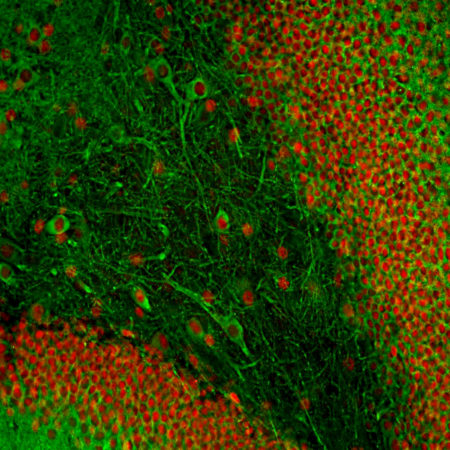
Mouse Monoclonal Antibody to MAP2A/B/C/D Cat# MCA-2C4
$120.00 – $800.00Select options This product has multiple variants. The options may be chosen on the product page -
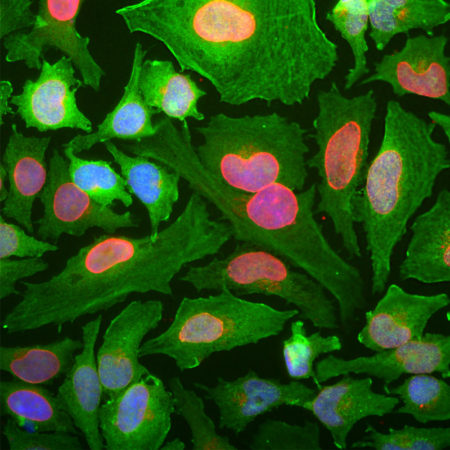
Mouse Monoclonal Antibody to DJ1/PARK7
$120.00 – $800.00
Cat# MCA-4H4Select options This product has multiple variants. The options may be chosen on the product page -
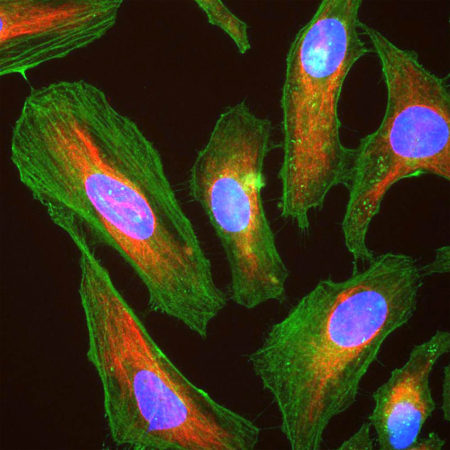
Mouse Monoclonal Antibody to all Actin Isotypes
$120.00 – $800.00
Cat# MCA-5J11Select options This product has multiple variants. The options may be chosen on the product page -
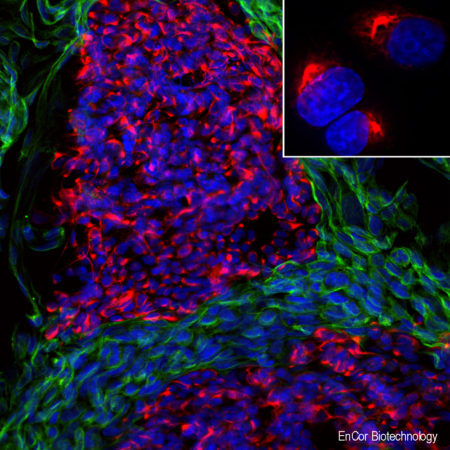
Mouse Monoclonal Antibody to Peripherin
$120.00 – $800.00
Cat# MCA-7C5Select options This product has multiple variants. The options may be chosen on the product page
Contact info
EnCor Biotechnology Inc.
4949 SW 41st Boulevard, Ste 40
Gainesville
Florida 32608 USA
Phone: (352) 372 7022
Fax: (352) 372 7066
E-mail: admin@encorbio.com

